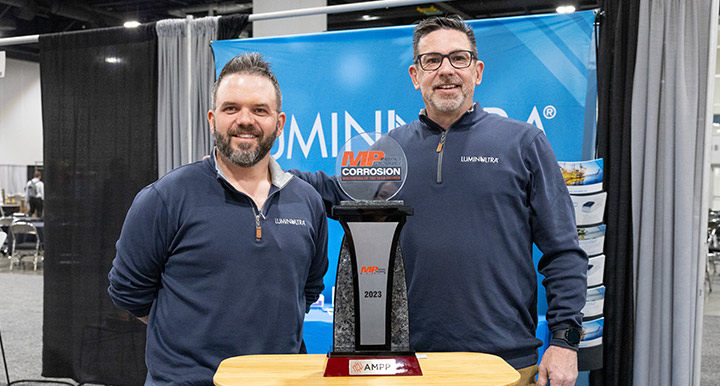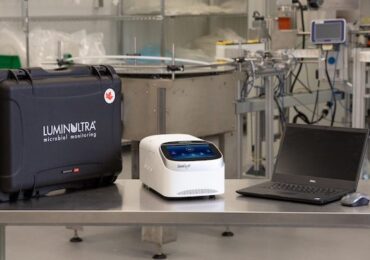Our team had the pleasure of attending the 2023 AMPP Annual Conference + Expo in Denver, Colorado, where we showcased our latest innovation in addressing microbiologically influenced corrosion (MIC). The GeneCount Corrosion Collection received a 2023 MP Corrosion Innovation of the Year Award, being named one of the “most promising technologies in the industry today.”
Here are some of our takeaways from the conference:
Assessing MIC risk requires a holistic approach
Microbiologically influenced corrosion (MIC) is a complex issue that involves the interaction between microorganisms, metal surfaces, and their surrounding environment. It’s crucial to gather as many of the puzzle pieces as possible to gain a better understanding of the risks associated with MIC in an oil and gas system.
This requires considering factors such as temperature, pH, and flow rate along with microbiological data to gain valuable insights into the growth and activity of microorganisms that cause corrosion. For instance, high flow rates can help disperse microorganisms and limit their growth, whereas low flow rates can create stagnant conditions leading to biofilm formation. Even seasonal temperature changes or changes in production chemicals can affect the balance of microbial communities and consequently the MIC risk present in a system.
This evidence complements microbial monitoring methods such as 2nd Generation ATP, qPCR and next generation sequencing (NGS) to deliver a holistic approach to mitigating MIC.
Microbial monitoring for MIC
| Technology | Description | Location | Frequency |
|---|---|---|---|
| 2nd Generation ATP | Understand the total active bioburden in a sample with a simple, fast, in-field test that gives quantifiable results and insight into the microbial growth of a system. | In-field | Daily |
| qPCR | Narrow in on corrosion-related microorganisms of concern with our ready-to-use qPCR assays. | In-field/Mail-in | Weekly/monthly |
| Next generation sequencing | Perform a Microbial Community Analysis for a complete overview of the microorganisms present in your sample. | Mail-in | Monthly/quarterly |
Metabolomics as a tool for MIC monitoring
Along with other -omics based analyses like genomics, an emerging laboratory tool for in-depth MIC risk assessment is metabolomics. Metabolomics involves the analysis of all metabolites present in a sample as a result of microbial activity using mass spectrometry. Paired with genomic data (qPCR or NGS), the use of metabolomics to analyze the metabolic fingerprint of a sample can provide valuable insights into the metabolic activity of a microbial community.
We saw this in a presentation by Iwona Beech from the Center for Biofilm Engineering at Montana State University: An Integrated Approach To The Study Of Microbially-Influenced Corrosion (MIC) Of X-65 Grade Carbon Steel In The North Sea Oilfield Installations. Their team used a combination of qPCR, NGS and metabolomics to analyze pigging solids from a high corrosion (HC) and low corrosion (LC) pipeline.
Beech et al. identified that the metabolomes and the microbial community dynamics differed between the HC and LC samples, but that the innermost layers of biofilm in both scenarios were more corrosive than the topmost community. This study showed the value of in-depth analysis of sessile biomass (biofilm) as opposed to reliance on planktonic biomass (liquid). It also underlines the value in using metabolomics and genomics to characterize a sample for identification of MIC.
Assessing MIC risk goes beyond the total bioburden in a sample
As our understanding of MIC grows, we know it’s important to go beyond just quantifying microbes to inform mitigation decisions in oil and gas systems. Using bug bottles, a culture-based method that’s been a mainstay of the industry for decades, is a familiar and common way to measure total bioburden.
But while bug bottles can identify viable microorganisms present in a sample, they cannot quantify non-viable or non-culturable microorganisms which can make up to 99% of biomass in a sample.
In contrast, qPCR provides a more comprehensive picture: it can quantify all microorganisms in a sample including non-viable or non-culturable cells that may be missed by culture analysis, and can provide information on the specific microbial populations present in a sample (for example, sulfate reducing prokaryotes).
Through molecular microbiological methods like qPCR, identification and quantification of important MIC biomarkers like micH for corrosive methanogens can be targeted. As we learn more about the impact micH plays in corrosion and asset failure, monitoring for methanogens that harbour the micH gene becomes critical. Detection of micH harbouring methanogens is not possible through culture-based methods.
A qPCR assay for micH is one of eight currently available as part of the GeneCount Corrosion Collection, along with sulfate-reducing prokaryotes (SRP), iron-reducing bacteria (IRB) and others. The GeneCount® Voyager puts this qPCR technology within arm’s reach to give you faster, simpler access to critical data to protect your systems from MIC.
Molecular Microbiology Methods (MMM) like qPCR and NGS are being integrated into industry standard test methods
As MMMs become more common and relied upon for microbiological analysis in industry, standard test methods are being built or revised to include them for more standardized testing and analysis across the industry.
A new AMPP standard test method TM21495 is in the works by AMPP subcommittee 22, biodeterioration, for laboratory evaluation of the effect of biocides on biofilms where MMMs will be listed. Additionally, AMPP standards TM0194 “Field Monitoring of Bacterial Growth in Oil and Gas Systems” and TM0212 “Detection, Testing, and Evaluation of Microbiologically Influenced Corrosion on Internal Surfaces of Pipelines” are being built upon to include language around MMMs.
The revision and creation of these standards underlines the industry interest in utilizing methods like qPCR and NGS for microbial monitoring and MIC risk assessment.
Join LuminUltra experts to learn how microbial monitoring techniques can help you identify and quantify the presence of problematic microbes in pipeline systems with same-day results.









